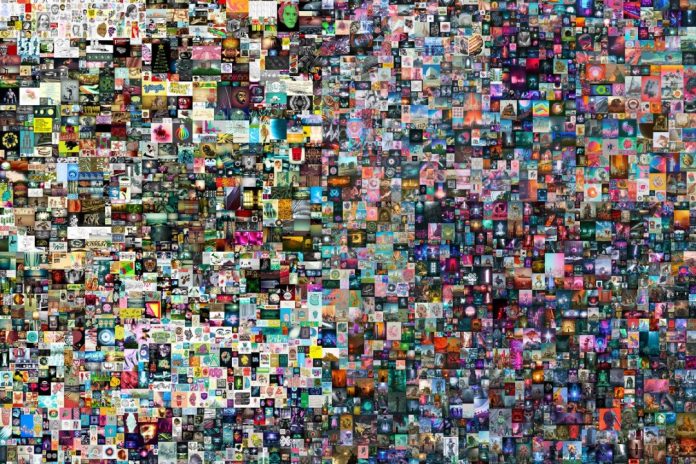
By Mohamad Taufiq Morshidi
A Non-Fungible Token aka NFT is a type of cryptographic token based on blockchain and cryptocurrency technology. However, unlike most cryptocurrencies, NFTs are not mutually interchangeable and are thus not fungible in nature. It’s like an arcade machine token where you trade in cash with a token used solely for arcade machines. NFTs are custom tokens that can be created (i.e. ‘minted’) on the blockchain, and then traded. NFTs can be minted as unique one-offs, or they can be limited edition runs (e.g. of a few dozen, hundreds, or thousands). And linking NFTs to other assets (physical or digital), seemingly introduces a scarcity to those assets that might otherwise be unattainable.
Now, why is this important? Because someone just sold art for $69 Million via an NFT.
Meet Mike Winkelmann, aka Beeple. He’s an artist who uses 3D imagery to create surreal, beautiful depictions of current events. And yes, he sold his entire catalogue into a mosaic for $69 million dollars.
Looks cool, doesn’t it? Yes, NFTs are a great avenue to discover art. As the COVID-19 pandemic has closed museums and art galleries worldwide, auction houses like Christie’s have resorted to using NFTs to sell artwork and it has been a lucrative business for the art world.

And that’s where the positive ends here.
The truth is that NFTs are destroying the environment. As temperatures increase worldwide, sea levels rise, sea ice is disappearing everywhere, widespread species extinction, countless severe weather events, and all the other hallmarks of total climate collapse, the wastefulness generated by NFTs is something that should be controlled or regulated.

To understand how wasteful NFTs are, here’s a comparison according to cryptoart.wtf:
The ecological cost of using the blockchain:
| Energy usage: | 390 kWh |
| Emissions: | 227 KgCO2 |
This means that a single NFT is equivalent to:
- Using a computer for 11 months
- An EU resident’s electricity consumption for 1.5 months
- Flying for 2 hours
- Driving 1 thousand Km (petrol)
- Boiling a kettle 4.5 thousand times
- Using a laptop for 3 years
This means that the concept of NFTs and technically most to all cryptocurrencies are dangerous to the environment overall in a bigger capacity than most countries, militaries and even corporations.
According to journalist Everest Pipkin, the reason why concepts like NFTs are so wasteful is due to the wasteful nature of cryptocurrencies itself. According to Everest:
To solve the problem of more computers mining, the proof of work puzzles get harder. Miners get more computers, better GPUs. The puzzles get harder. Miners move to places with cheap electricity. The puzzles get harder. Miners retrofit warehouses, air-condition shipping containers. The puzzles get harder. Monumentally harder.
After a decade+ of a growing cryptocurrency market, what we’ve been left with is a financial network that uses more energy than Argentina, with no regulatory structure or federal oversight whatsoever.
This is not a new problem; the ecological devastation rendered by an out of control proof of work system has been written about for almost as long as cryptocurrency has been around.
And lest you think we are dealing in long-term abstractions- this devastation has tangible, externalized cost; a recent study out of the University of New Mexico estimated that in 2018 every RM4.12 of Bitcoin value was responsible for RM2.02 in health and climate damages in the US, costs that are borne by those who will, for the most part, never see any return from cryptocurrency mining whatsoever.

This also doesn’t help by the fact that currently many industries are suffering from a silicon shortage that has caused an increase in pricing for things like GPUs and computing processors for vehicles, as COVID-19 makes supply and demand between manufacturers and factories difficult to continue. The growth of NFTs therefore require the increasing demand for components needed for growing NFTs, which further creates more environmental problems as factories and manufacturers have to keep up with supply and demand in a shrinking silicon supply.
Another problem with the unsustainability of NFTs is that, well, it’s unsustainable. The only reason why NFTs are booming right now is due to Covid-19. What happens when the pandemic is over, and all the museums, art galleries and art fairs start reopening? Will The NFTs continue or will the average art buyer go back to the average art fair? As Everest Pipkin stated:
If I had to guess, I’d say the NFT market will replace absolutely nothing- will cause no wasteful, physical art fairs to close- but will instead be folded into existing art fair and gallery contracts. This is because cryptoart is a perfect match to how the art market already functions.
Much like the world of blue chip, some NFTs may be bought and sold simply as artworks, intended for personal collections and acquired for aesthetic, conceptual, or personal reasons. However, every single one is made from the outset to be liquidated – an asset first, artwork second. They are images attached to dollar figures, not the other way around.
However, is there any “greentech” solution to this problem? Not really, unfortunately. Because cryptocurrency AND cryptoart are fundamentally valuable because they burn energy. Because they turn sunk energy cost into futures. Just like how cars rely on constant supply of petroleum to continue, cryptoart would need constant mining of cryptocurrency just to continue to thrive. However, unlike petroleum cryptoart and cryptocurrency are not regulated by any government or public body, and that’s the problem. Government regulation might not really solve the environmental issues caused by NFTs, but it’s a first step to finding out a sustainable alternative to the massive energy consumption caused by NFTs. To summarize, here’s Everest Pipkin one last time:
The only viable option is total moral rejection. Anything less (selling, collecting, posting links to artists selling NFTs, yes even trying to find a less ecologically devastating model) holds up the power of the worst parts of this platform. It grants moral grayzone- an “oh, if my favourite artist is involved, maybe it isn’t so bad?” or a “but I know this person cares for the environment and they participate – maybe they know something I don’t?”I understand first-hand the desperation of trying to live in a world that has systemically undervalued and undercut the arts, and how compelling a vision of escape can be. I truly do want to live to see the world that rewards artists for making the work they would like to make without asking them to jeopardize their health, stability, and creative integrity. This is not just my political belief – it is a desire that would directly benefit me and those I love. It is a future I have to believe in to keep going every day. – New Malaysia Herald



New Malaysia Herald publishes articles, comments and posts from various contributors. We always welcome new content and write up. If you would like to contribute please contact us at : editor@newmalaysiaherald.com
Facebook Comments